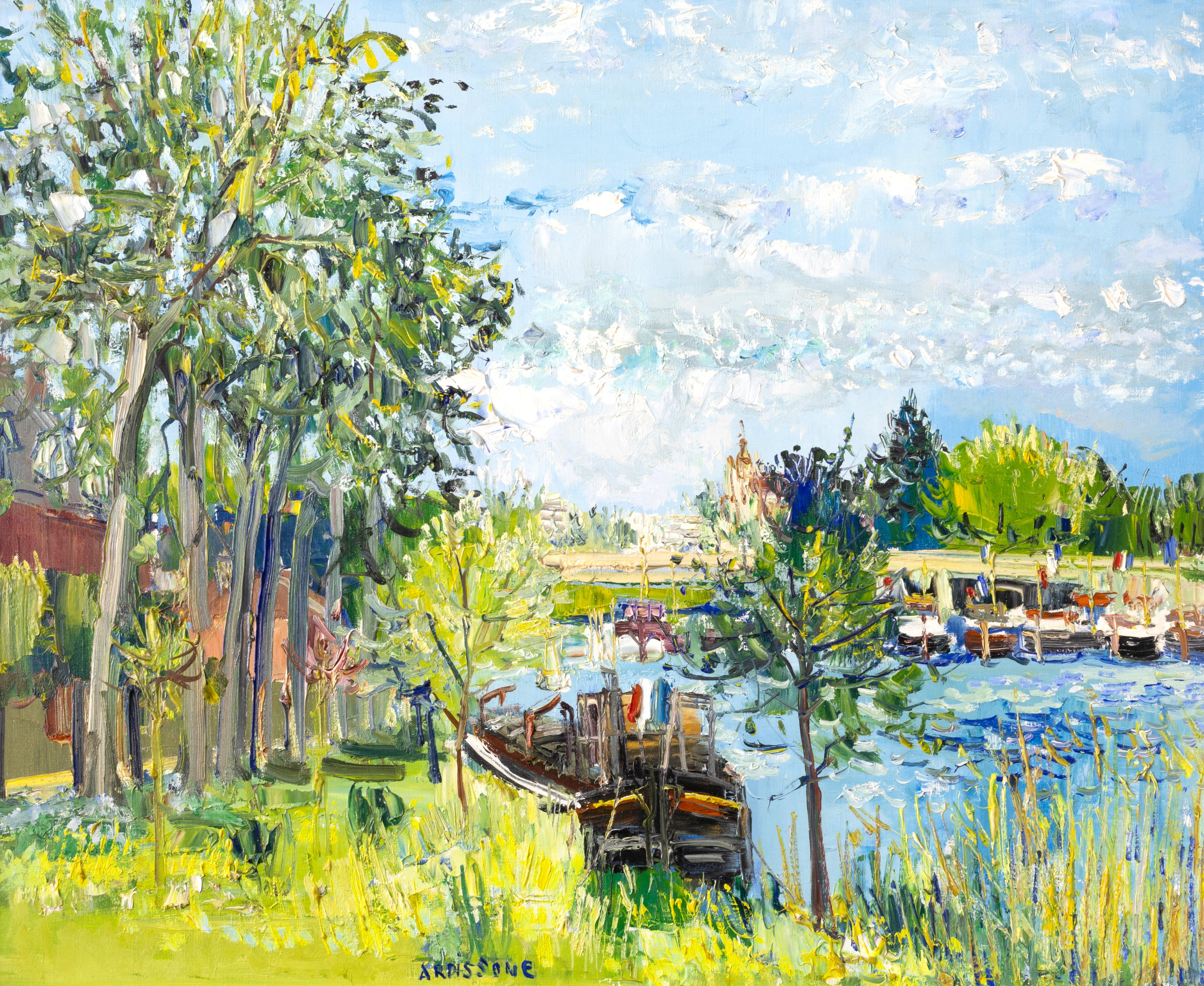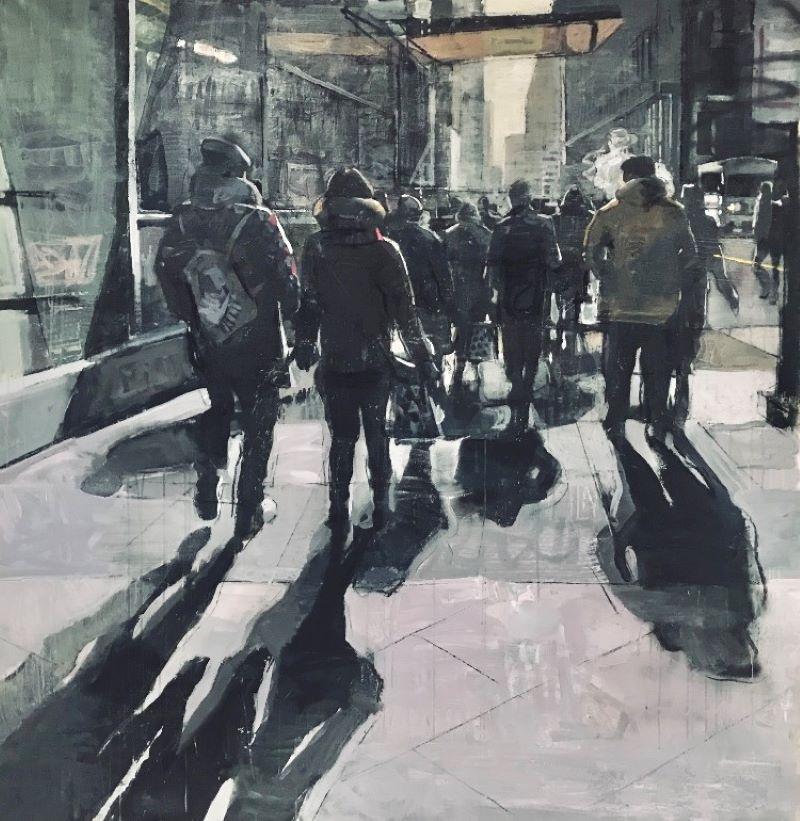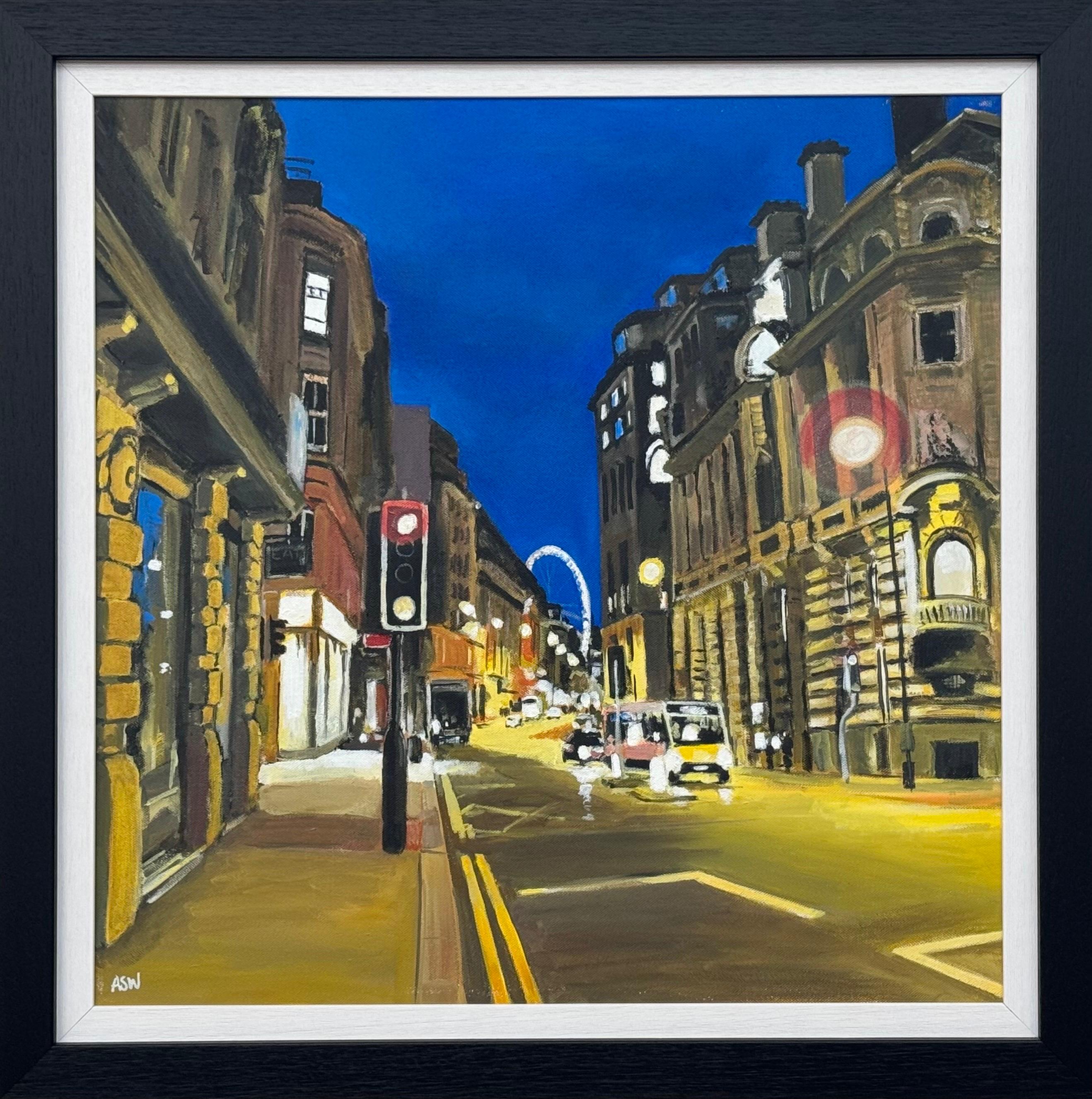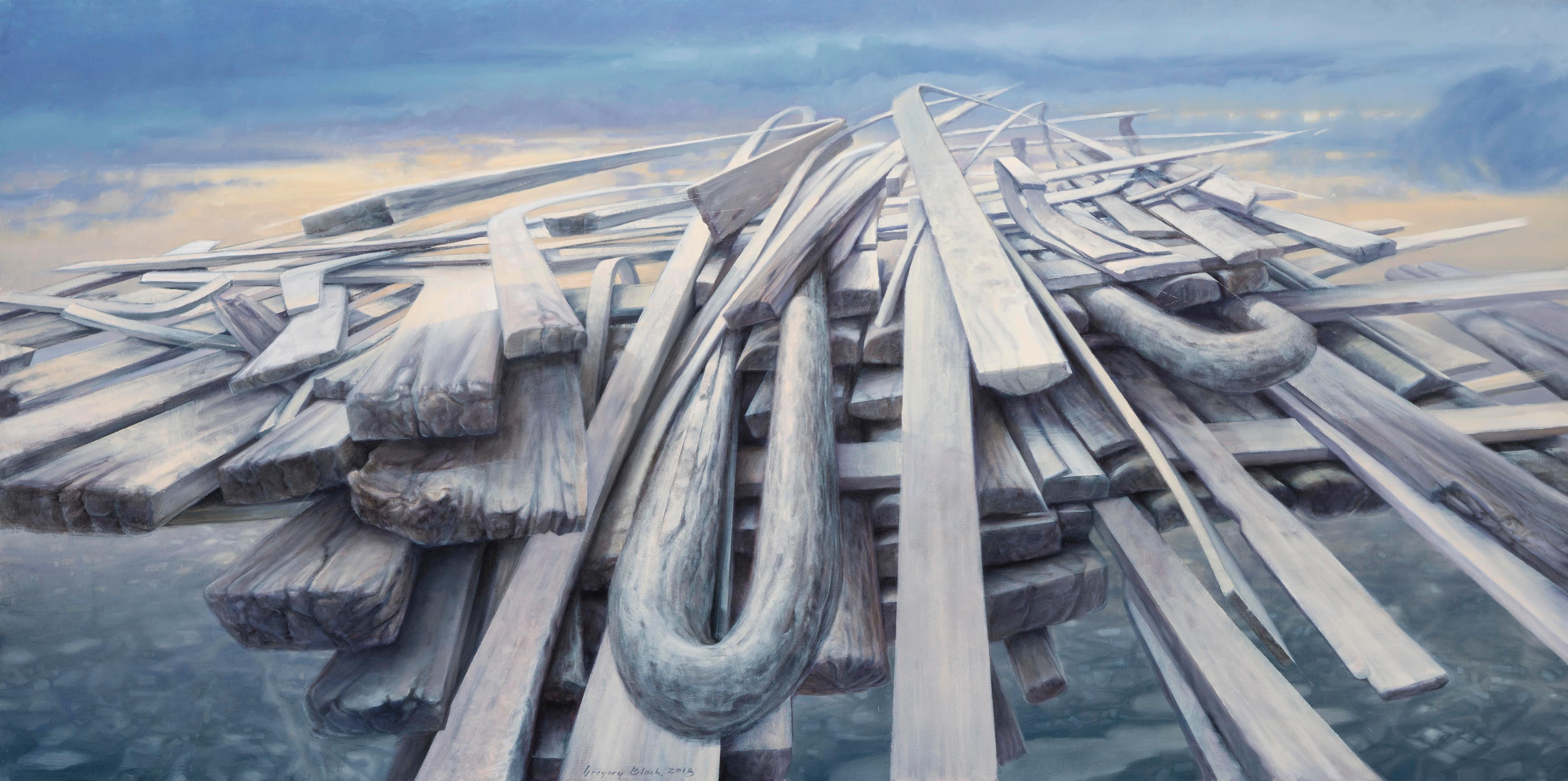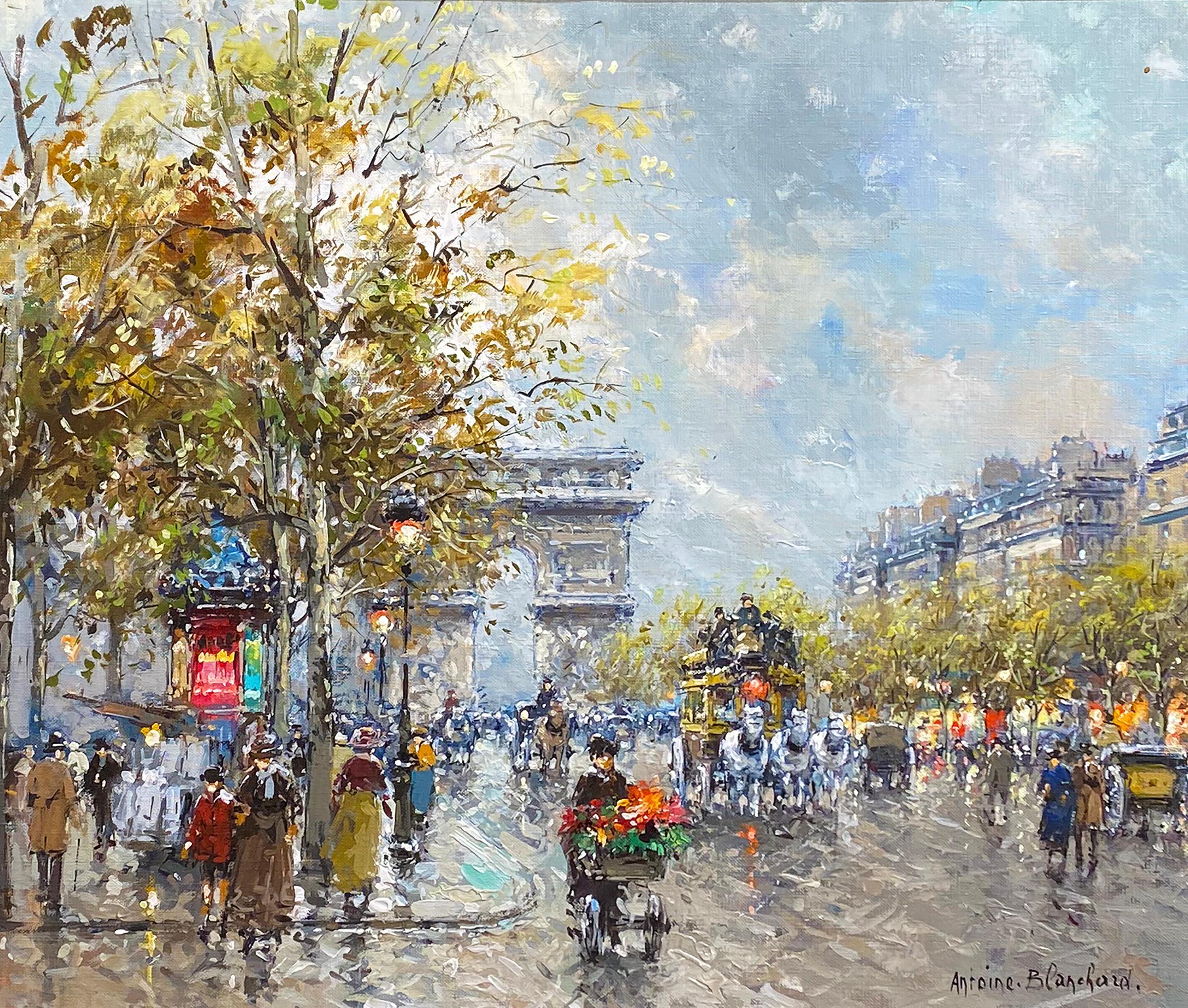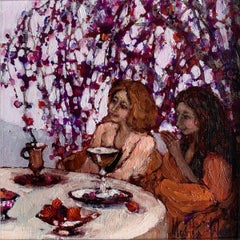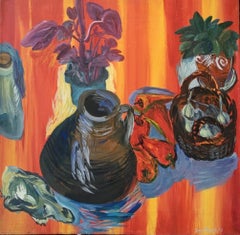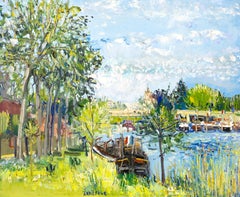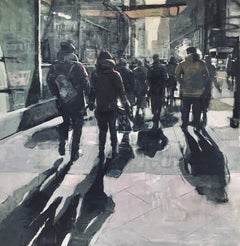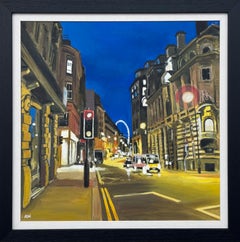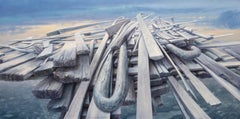Items Similar to Portrait in a green dress. Figurative oil painting, Polish artist
Want more images or videos?
Request additional images or videos from the seller
1 of 7
Lidia WiencekPortrait in a green dress. Figurative oil painting, Polish artist2008
2008
About the Item
Contemporary figurative oil on canvas painting by Polish artist Lidia Wiencek. Artwork depicts woman wearing blue dress, sitting by the window. Woman has her eyes closed. Thorugh a window, there is a landscape visible. Colors of this painting are mostly blue, nude and green.
LIDIA WIENCEK (born in 1974)
She studied at the Academy of Fine Arts in Cracow in 1994-1997. She graduated in 1999 from the Academy of Fine Arts in Warsaw (atelier of professor Janusz Stanny).
"The depictions of women in my pictures are a very subjective record of some images still-framed in my unconsciousness. In my mind I have visions of many new paintings, but yet I paint spontaneously. When a new canvas is being made, it is not until the very first strokes that I have any idea of how it will look like. I paint some schemes of silhouettes, one after another, and I wonder how to arrange them. Then I start to make choices, I search for the perfect colours and forms..." This is how this emerging painter, whose achievements already account for the long way she has been through, describes her creations. Soon after her graduation from the Academy of Fine Arts she freed herself from the academic manners and started creating her autonomous world reflecting the reality. The creation of pictures is not a defined process, every next layer of the paint reveals the hidden visions. When studying the pictures of Lidia Wiencek we are moved by its great emotional charge, mood and feelings expressed by simple methods. The compositions reveal psychological beauty in a synthetic way. Due to this, in such an art beauty becomes manifestation of truth, as it was meant by Hegel.
PROVENANCE
Exhibited at Katarzyna Napiorkowska Gallery.
The Gallery is a primary representative for this artist.
The Gallery of Katarzyna Napiorkowska is one of the first private art galleries in Poland. For over 30 years, the gallery has been presenting contemporary paintings, graphics, drawings, and sculptures. Our galleries are located in Warsaw and Brussels. The portfolio of the Gallery includes selected objects of renowned Polish artists. In 2015, our Gallery was awarded the prestigious title of the Ambassador of the Polish Economy in the European Brand category awarded by the Business Center Club.
CONDITION
Very good condition.
SHIPMENT
The painting may arrive rolled in a strong tube or a box. Such a transport method is very safe for oversized works and provides lower shipping costs as well. Rolled works can be easily stretched by placing canvas onto wood stretcher bars and/or framed by a local framer upon arrival.
- Creator:Lidia Wiencek (1974, Polish)
- Creation Year:2008
- Dimensions:Height: 35.44 in (90 cm)Width: 31.89 in (81 cm)
- Medium:
- Period:
- Condition:Can be sent rolled with the stretchers Painting is sold unframed.
- Gallery Location:Warsaw, PL
- Reference Number:Seller: 33781stDibs: LU1010114570832
About the Seller
5.0
Platinum Seller
Premium sellers with a 4.7+ rating and 24-hour response times
Established in 1987
1stDibs seller since 2018
502 sales on 1stDibs
Typical response time: 2 hours
- ShippingRetrieving quote...Shipping from: Warsaw, Poland
- Return Policy
Authenticity Guarantee
In the unlikely event there’s an issue with an item’s authenticity, contact us within 1 year for a full refund. DetailsMoney-Back Guarantee
If your item is not as described, is damaged in transit, or does not arrive, contact us within 7 days for a full refund. Details24-Hour Cancellation
You have a 24-hour grace period in which to reconsider your purchase, with no questions asked.Vetted Professional Sellers
Our world-class sellers must adhere to strict standards for service and quality, maintaining the integrity of our listings.Price-Match Guarantee
If you find that a seller listed the same item for a lower price elsewhere, we’ll match it.Trusted Global Delivery
Our best-in-class carrier network provides specialized shipping options worldwide, including custom delivery.More From This Seller
View AllA walk with the cat. Oil figurative painting, Pastel colors, Polish artist
By Martta Węg
Located in Warsaw, PL
Contemporary figurative oil on canvas painting by Polish artist Martta Węg. Painting depicts woman and a girl standing next to tree. There is a cat next to them. Colors are pastel. T...
Category
Early 2000s Other Art Style Figurative Paintings
Materials
Oil, Canvas
Meeting after years 2. Oil figurative painting, Vibrant colors, Polish artist
By Martta Węg
Located in Warsaw, PL
Contemporary figurative oil on canvas painting by Polish artist Martta Węg. Painting depicts women sitting at the table outside. Colors of this painting are mostly red, pink, brown a...
Category
Early 2000s Other Art Style Figurative Paintings
Materials
Canvas, Oil
Still life. Oil on canvas figurative painting, vibrant, Polish female artist
Located in Warsaw, PL
Colorful 20th Century oil on canvas painting by Polish artist Ewa Bajek. Painting depicts still life with vegetables, animal skull, glass and plants in pots....
Category
1990s Contemporary Still-life Paintings
Materials
Canvas, Oil
The struggle between good and evil - XXI Century, Figurative Oil Painting
By Malgorzata Rozmarynowska
Located in Warsaw, PL
MALGORZATA ROZMARYNOWSKA (born in 1955)
She studied in the Public High School of Plastic Arts at the Department of Painting and Graphic and graduated in 1981 in Professor Wladyslaw J...
Category
2010s Contemporary Figurative Paintings
Materials
Oil, Canvas
Parrots 17. Figurative Oil Painting, Colorful, Pop art, Animals, Polish artist
By Rafał Gadowski
Located in Warsaw, PL
Contemporary figurative oil on canvas painting by Polish artist Rafal Gadowski. Painting in pop art style depicting parrots. Painting is vibrant. Main colours are red, green, yellow ...
Category
2010s Other Art Style Figurative Paintings
Materials
Canvas, Oil
Panther 10. Figurative Oil Painting, Colorful, Pop art, Animals, Polish artist
By Rafał Gadowski
Located in Warsaw, PL
Contemporary figurative oil on canvas painting by Polish artist Rafal Gadowski. Painting in pop art style depicting a panther. Painting is vibrant. Main colours are orange and blue. ...
Category
2010s Other Art Style Figurative Paintings
Materials
Canvas, Oil
You May Also Like
Bateau Sous la Pont
By Yolande Ardissone
Located in Missouri, MO
Bateau Sous la Pont
Yolande Ardissone (French, b. 1927)
Oil on Canvas
Signed Lower Center
30.25 x 25.25
31.5 x 36.5 inches with frame
Born in Normandy on June 6, 1927 to an Italian ...
Category
Late 20th Century Impressionist Landscape Paintings
Materials
Canvas, Oil
Price Upon Request
"Double Shadow", Oil Painting
By Kevin Weckbach
Located in Denver, CO
Kevin Weckbach's (US based) "Double Shadow" is an original, hand made oil painting that depicts a busy city avenue filled with throngs of bundled walkers casting long shadows on the ...
Category
2010s American Realist Landscape Paintings
Materials
Oil, Canvas
Deansgate Manchester City Urban Night Scene by Contemporary Britain Artist
By Angela Wakefield
Located in Preston, GB
Deansgate Manchester Urban City Scene at Night by Contemporary British Artist, Angela Wakefield.
Art measures 24 x 24 inches
Frame measures 29 x 29 inches
This striking painting of...
Category
2010s Contemporary Landscape Paintings
Materials
Gesso, Canvas, Paint, Cotton Canvas, Oil, Acrylic
"Skyraft, " Oil Painting
By Gregory Block
Located in Denver, CO
Gregory Block's (US based) "Skyraft" is an original, handmade oil painting that depicts wooden debris floating in an expansive skyscape.
Gregory was born in Kansas City, Missouri, ...
Category
2010s Surrealist Figurative Paintings
Materials
Oil, Canvas
Colorful Purple, Pink, & Green Modern Portrait of Man Playing Billiards or Pool
By Gerald Garston
Located in Houston, TX
Colorful modern figurative portrait of a man playing billiards or pool by Connecticut artist Gerald Garston. The work features a man in a blue bowler ha...
Category
1970s Modern Figurative Paintings
Materials
Canvas, Oil
Avenue des Champs-Elysses, Paris
By Antoine Blanchard
Located in Missouri, MO
Antoine Blanchard (French 1910-1988)
"Avenue des Champs-Elysses, Paris"
Oil on Canvas
Signed
approx 18 x 22 (site)
approx 26.5 x 30 (framed)
Antoine Blanchard (c.1910-1988) was a prolific and successful Neo-Impressionist painter who specialized in nostalgic scenes of Fin de Siècle Paris. Inspired by the subjects as well as the success of earlier painters of Parisian life like E. Galien Laloue (1854-1941), Edouard Cortès (1882-1969), Jean Béraud (1849-1935) and Luigi Loir (1845-1916), Blanchard painted hundreds of views of the “City of Light.” In the late 1950s, his street scenes were exported to the United States and the United Kingdom, where they were sold briskly to collectors. By the1960s, Blanchard paintings were bringing several hundred dollars in galleries, so while they were not inexpensive, they were affordable to collectors who loved Parisian scenes but who could not afford the works of Cortes or one of the other French painters known for their views of Paris in Belle Époque. Eventually Blanchard’s more delicate, feathery pastel-toned scenes of rain-swept Paris became sought after in their own right and, when he died, he was considered the last of what the dealers described as the École de Paris or “School of Paris” painters.
The most salient fact about the life and career of the painter Antoine Blanchard was that he was actually born Marcel Masson, the son of a furniture maker who lived in the scenic Loire Valley, south of Paris, where the French nobility had their chateaus. The date that is usually given for Blanchard’s birth is November 15, 1910. However, there has been some speculation that he was born even later, perhaps in 1918, but some of the facts of his life have always been clouded by early biographies that claimed even earlier dates for his birth, so that he would seem to be seen as a contemporary of the famous Belle Époque painters rather than a post-war interpreter of Paris.
Blanchard grew up in the hardscrabble years following the First World War. Because he was artistically talented, he was sent first to the nearby city of Blois, the capital of the Loir-et-Cher Département, for artistic training and then to the École des Beaux-Arts in Rennes, on the Brittany peninsula, where he received a classical art education. By some accounts Blanchard also studied in Paris, where the historic École des Beaux-Arts is located, but the depth of his study and the style of his earliest work will require further research.
Marcel Masson was married in 1939, as war clouds gathered on the French horizon. He was drafted for service in the French Army and participated in the short and futile struggle against the invading German Panzers before returning to his family and his art during the Nazi occupation. A daughter, Nicole, was born in 1944 with a second daughter, Eveline, who eventually came to the United States, following in 1946.
Masson’s early art career was interrupted, first by World War II and later by the necessity of keeping his father’s workshop running in the years after his death. By the late 1940s, though, Masson returned to his art and moved to Paris in order to further his career.
Exactly when Marcel Masson adopted the pseudonym Antoine Blanchard is not known, nor are we aware of his motivations for adopting a nom de plume, but the practice was not unusual for French painters. In most cases a pseudonym was adopted because the artist had contractual obligations with more than one agent or dealer. Another motivation could be to obscure the scope of a sizable artistic production. Dealers in that era also liked to keep an artist under their thumb, so a pseudonym was a way for Blanchard’s dealers to tuck him away, out of the sight of their competitors.
Like many painters before him Masson may have initially painted different subjects under different names. Marcel Masson neé Blanchard would have been well aware that the famous and prolific French painter E. Galien Laloue (1854-1941) painted under no less than four names – three pseudonyms in addition to name he was christened with – and so the adoption of another name was probably not seen as a liability to him.
However, he apparently never took the step to register his pseudonym, which was possible in France, to legally restrict its use. In any event, by the 1950s Marcel Masson had become “Antoine Blanchard,” a painter of Parisian views. With the aging Edouard Cortès (1882-1969) as a model, Blanchard began to specialize in romanticized scenes of la ville des lumières, or the “City of Light.”
However, instead of painting contemporary Paris, the crowded metropolis of his own time, which he may have felt was lacking in romance, he chose to look at the French capital through the rear-view mirror. So Blanchard became known for his depictions of the hurly-burly life of Paris in the Belle Époque. For inspiration, he is said to have collected old sepia-toned postcards of life in La Belle Époque (“The Beautiul Era”), the long period of peace and relative prosperity between the end of the Franco-Prussian War and the horrors of the Paris Commune in 1871 and the start of the mass bloodshed of the First World War in August of 1914. In addition, however, the paintings of Loir, Baraud, Laloue and Cortès could be found and studied in the flea markets of Paris as well as the auctions at the l’Hôtel Drouot.
Reminders of the Belle Epoch were thus all around Blanchard, and of course the architecture that he painted had survived the Second World War intact, because Paris was spared bombing or a siege by the allies. Soon he was painting the horse-drawn omnibuses that took turn-of-the-century Parisians on longer trips throughout the city as well as the tradesmen, children and fashionably dressed ladies that populated Baron Haussmann’s Grand Boulevards.
Blanchard’s early work was clearly modeled after the paintings of Edouard Cortès, but he was always his own man and never a slavish copyist. These paintings were darker in palette than the later Blanchard paintings most American collectors have become familiar with, and his red and blue tones were often bolder than those of Cortès. He never adopted the heavy “impasto,” the build-up of paint on the highlights of Cortes’ work, leaving that artistic trademark to the master. Blanchard’s brushwork was painterly, but the buildings in the paintings were always well rendered, for he had an excellent command of composition and perspective.
By the late 1950s, agents began to purchase Blanchard’s paintings and then to export them to the United States, selling them to commercial galleries in far away Houston, Los Angeles, San Francisco, Chicago and New York. By the early 1960s, his work was already well known enough to be in reproduced by print publishers and the Donald Art Company published a number of popular prints that are now often mistaken for original paintings. By the end of the 1960s, Blanchard had begun to develop his own mature style by employing a lighter, brighter, palette and a deft, almost calligraphic style of brushwork. This helped him step out of Cortès’ shadow and become a sought-after painter in his own right. Blanchard worked through agents, essentially brokers, who purchased his work and created a demand for it in the United States and Canada.
By the 1970s Blanchard’s paintings were being sold by galleries across the United States, and the American market absorbed virtually all of his work. In 1969, with the passing of Edouard Cortès, he became the last of the long series of prolific French painters of Parisian life. Blanchard’s later works were usually daylight scenes, with Paris seen awash in rain or with a mantle of soft snow, and so collectors no longer confused him with Cortes, whose Parisian clock seemed to always be set at twilight. These paintings were rendered in softer, pastel tones and he used his brush with a light touch. These qualities gave Blanchard’s work of the 1970s and 1980s a lighter, more decorative appearance.
In the late 1970s, the French agent Paul Larde published a lavish book that was claimed to be an authorized biography of Antoine Blanchard by his “exclusive” dealer. Today, this book is almost impossible to find, because it was apparently the subject of a lawsuit in France. Some of the information in the Larde book was contested and found to be inaccurate and so it was withdrawn from publication.
One claim that Larde made was that Blanchard’s production was extremely limited. While he was not as prolific as Cortès or Laloue, he was a hard-working painter who managed to supply a long list of galleries with his work. He produced thousands of paintings during his career. When the motivation for a monograph is marketing rather than art history, accuracy and detail can be swept aside by exaggeration, hyperbole and claims of exclusivity that were meant to discourage collectors or galleries from buying Blanchard’s from other representatives. Blanchard’s legitimate paintings were sold by several agents, who dealt directly with the artist, at least one of whom was American, one Austrian and a few French dealers.
The details of Antoine Blanchard’s life are not well known because he never sought the limelight. He was content to work in his studio and ship his paintings to his agents who sold them abroad. Eventually both his daughters – Nicole and Evelyn – followed in his footsteps and became painters themselves. Evelyn (1946-2008) was savvy enough to adopt the Blanchard nom de plume, and she began painting street scenes that closely resembled her father’s later work.
Antoine Blanchard passed away in 1988, leaving hundreds of paintings of Belle Époque Paris– the Notre Dame Cathedral, the Opera, the Arc de Triomphe and Place Concorde – as his lasting legacy.
Notes on the Authentication of Antoine Blanchard’s Paintings:
The vast majority of Blanchard’s paintings were smaller works, which were sent to the United States in tubes and stretched and framed by the galleries that sold them. Virtually all of these Blanchards were painted in European centimeter sizes, which convert to 13” x 18” or 18” x 21 1/2?, but on very rare occasions he painted much larger works in American sizes – such as 24” x 36” – on commission for dealers such as Howard Morseburg in Los Angeles or the dapper Wally Findlay, who had a chain of galleries. The first way to assess the authenticity of a Blanchard...
Category
Mid-20th Century Impressionist Landscape Paintings
Materials
Canvas, Oil
Price Upon Request
Recently Viewed
View AllMore Ways To Browse
New Arrivals Sculptures
1974 Dresses
Woman Stretching Sculpture
Graduation Dresses
Atelier Green Dress
Oversized Blue And Green Art Sculpture
Oversized Sculpture Blue And Green Art Sculpture
Vintage Voodoo Art
Women Swimming Oil Painting
2007 Vintage Valentino
Acrylic Aquarium
Alfred Adams
Assumption Of The Virgin
Barrett Paris
Brazil Favela
Dancing Pigs
Derek Harrison
Eric Zenner
